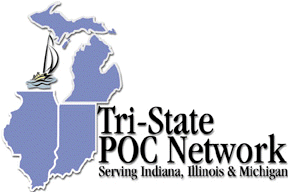
HIGHLIGHTS
FROM THE OCTOBER 6, 2010 TRI-STATE POC NETWORK MEETING
“Understanding LEAN Sigma & Impact on Efficiency”
"Roundtable Discussions"
“Modern
Concepts for Inpatient Glucose Control”
The 2010 fall meeting and Vendor Fair
was held at the Doubletree Hotel in Alsip, Illinois on Wednesday,
October 6 from 9:00 AM to 3:30 PM.
The meeting was attended by 49 registered
healthcare professionals and sponsored by MAS and Abbott. The
Vendor Roster included representatives from Abaxis, Abbott Diabetes
Care, Abbott i-Stat , Alere, Axis-Shield, BD, Beckman Coulter,
Fisher Healthcare, Helena, Hemocue, Instrumentation Laboratories,
ITC, Laboratory Data Systems, Masimo, Nova Biomedical, MAS, Quidel,
Radiometer, Roche, Siemens, Telcor and Thermo-Fisher.
The meeting commenced with opening remarks
by Joanne McEldowney, RN. Members of the core group include: Wendy
Denk, Ingalls Hospital, Harvey, IL; Joanne McEldowney, RN, Univ of
Illinois – Chicago, Chicago, IL; Gil Salas, Univ of Illinois –
Chicago, Chicago, IL and Sandra Curran, Univ of Illinois.
The first session, “Understanding
LEAN Sigma & Impact on Efficiency”, was presented by Paul
Cantrell, Department of Pathology, UIMC, Six Sigma Green-Belt and
was sponsored by MAS. This introduction to some fundamental basics
of LEAN and 6 Sigma started with WHFM, which translates to “What’s
In It For Me?” and definitions of Sigma, 6 Sigma and LEAN. For the
uninitiated, Sigma is a term used to represent standard deviation,
an indicator of the degree of variation in a set of measurements or
a process. 6 Sigma is a statistical concept that measures a process
in terms of defects – at the 6 Sigma level, there are only 3.4 DPMO
(defects per million opportunities). 6 Sigma is also a philosophy
of managing that focuses on eliminating defects through practices
that emphasize understanding, measuring and improving processes. As
for LEAN (and who hasn’t been striving for LEAN recently?) is an
operational strategy oriented toward achieving the shortest possible
cycle time by eliminating waste.
Imagine three shifts, each doing their own
thing. By performing in this method, the risk for error is
increased, whereas, everyone following the same protocol, procedure,
process, etc. reduces the risk of error and increases productivity.
As for multitasking? The process of multitasking is the ability of
being able to screw up more things at the same time. Sigma and LEAN
have been successfully used by many companies and it is now time for
healthcare to overcome the barriers of “common errors’’ and make the
commitment of “Virtual Perfection”. Healthcare can’t continue to
be average but needs to adopt the same strategy principles (6 Sigma)
that were utilized by Toyota, Amazon.com, Pepsi, Quest (to name a
few) to become great. And how can 6 Sigma and LEAN tools help the
POCT group? They help identify, quantify and verify root causes;
they can identify customer Critical to Quality (CTQs = the I want to
needs); maximize efficiencies and effectiveness in processes; reduce
variation through standardization; identify and differentiate
between non-value added steps and value added steps; provide
effective problem resolution; and substantiate requests for
resources with quantifiable data. So, the next time you have
2 analyzers doing the work of 4 analyzers, use LEAN and 6 Sigma
means (proactive systems to gather information, not reactive
systems) to evaluate the process, quantify your data, and
present this data (use flow charts, spaghetti charts, Fish Charts,
etc) to administration for additional equipment.
The Tri-State POC Network thank the
vendors in attendance for their representation and support of the
October Vendor Fair.
Following the Vendor Fair and lunch,
Sandra Curran led the Roundtable
Discussions. Her questions to the group were:
-
How are POCC’s addressing the 6
required measures of competency for the ACT test?
-
Does anyone have a diabetes task force
in place that focuses on data collection of hyperglycemic events
for purposes of finding approaches to minimize these events?
-
Is anyone cleaning the meters after
every use and if so, how is it being done?
-
Has anyone changed work processes or
made efforts to accommodate the changing economy?
The final presentation, “Modern
Concepts for Inpatient Glucose Control” was led by David
Baldwin, MD, Director of Endocrinology, Rush Medical Center and
sponsored by Abbott. Dr. Baldwin presented these facts: in the
1990s, hospital discharge forms listing diabetes as diagnosis was
>50%, in 2002, diabetes accounted for >4.9 million hospital
admissions at a cost of $40 billion, yet, inpatient hyperglycemia
treatment is sub-optimal in many hospitals. Hyperglycemia is linked
to Mortality regardless of Diabetes status and is a common
co-morbidity in medical-surgical hospitalized patients. The length
of stay is generally higher for the new hyperglycemia than for
normoglycemic or known diabetic, the new hyperglycemic is more
likely to require ICU and to need transitional care after discharge,
and they trend toward a higher rate of infections and neurologic
events. Rush has eliminated the usual method of treating glycemia
(The Sliding Scale) and have established an Inpatient Diabetes
Management team to provide a continuity of care from ICU to general
floor to rehabilitation to discharge as well as utilize an Insulin
Protocol in the Emergency Department.
The next
meeting will be in April 13, 2011 at the Doubletree Hotel in Alsip.
Respectfully Submitted,
Wendy Denk, MT(ASCP)